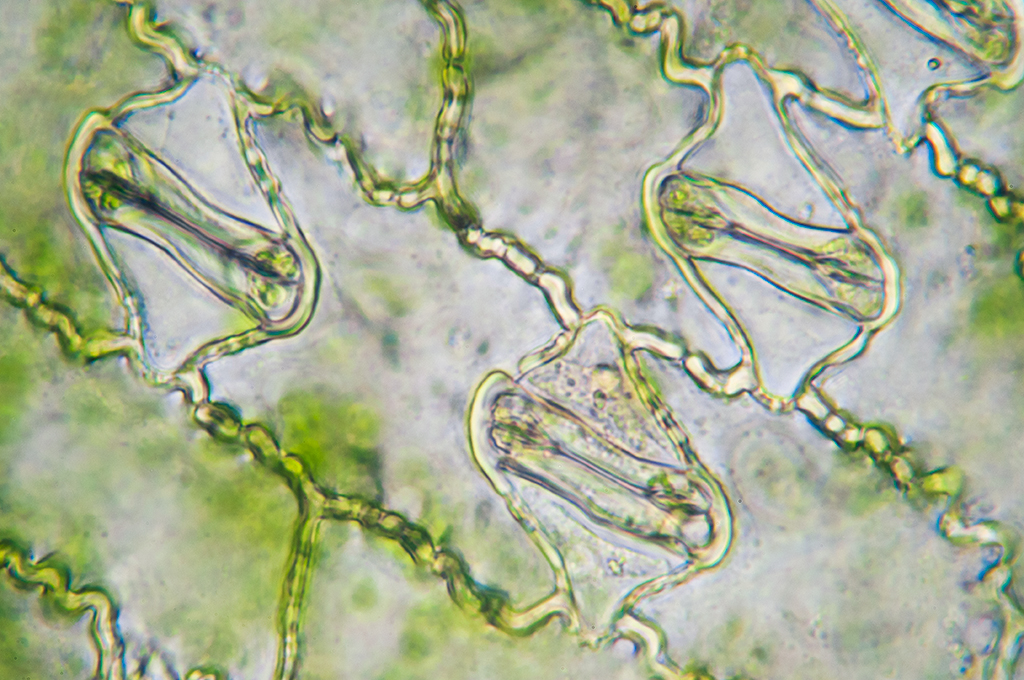Stomata, tiny pores found on the surfaces of leaves and stems, are crucial for a plant’s survival. They facilitate gas exchange, playing a vital role in photosynthesis and respiration. This article delves into the world of stomata, exploring their structure, function, and the sophisticated mechanisms they employ to sustain plant life.
Stomata Explained
| Feature | Explanation |
|---|---|
| What are they? | Microscopic pores on leaves and stems that control gas exchange between plants and the atmosphere. |
| What do they do? | * Allow CO2 intake for photosynthesis. * Release O2 produced during photosynthesis. * Release water vapor through transpiration. |
| Structure of a stomata: | * Guard cells: Bean-shaped cells surrounding the pore, controlling its opening and closing. * Pore: Tiny opening between guard cells for gas exchange. |
| Importance of stomata: | * Crucial for plant survival through photosynthesis, respiration, and transpiration. * Impact global climate by regulating CO2 and water vapor in the atmosphere. * Adapt to environment with variations in number and distribution depending on plant species and climate. |
| Fun facts: | * Thousands of stomata per leaf! * Size and distribution vary across plant species and environments. * Open and close throughout the day, most open during photosynthesis and closed at night to conserve water. |

Key Takeaways
- Structure: Stomata consist of two guard cells forming a pore.
- Function: Facilitate gas exchange and regulate water loss.
- Types: Differ in distribution and size across plant species.
- Response to Environment: React to light, humidity, and internal signals.
Understanding Stomata: Structure and Function
Stomata are composed of two guard cells that create a pore, known as the stoma. These cells are unique in their ability to change shape, thereby opening or closing the pore. This dynamic ability is essential for regulating the plant’s gas exchange process.
Gas Exchange and Transpiration
The primary role of stomata is to allow for the exchange of gases. They let carbon dioxide (CO2) in for photosynthesis and release oxygen (O2) as a byproduct. Simultaneously, water vapor escapes through these pores in a process known as transpiration.
Regulation of Stomatal Opening
Stomatal opening is influenced by various factors:
- Light: Stomata generally open in light and close in darkness.
- Humidity: They respond to changes in humidity to optimize water use.
- Internal Signals: Hormones like abscisic acid signal the stomata to close during water stress.
Types and Distribution of Stomata
Stomata vary in their distribution on leaves, often more abundant on the underside in many species. This placement minimizes water loss while optimizing gas exchange. The density and size of stomata can vary significantly among different plant species, reflecting their adaptation to diverse environments.
Stomata in Action: Real-World Applications
Understanding stomatal behavior has practical implications in agriculture and environmental science. For instance, manipulating stomatal density or responsiveness could lead to crops that are more efficient in water use or better adapted to changing climate conditions.
Technological Insights: Stomata and Innovation
Recent advancements in microscopic imaging and environmental sensing technologies have provided deeper insights into stomatal dynamics. These technologies enable scientists to study stomatal behavior under various environmental conditions, leading to better crop management strategies.
Stomata and Plant Health
Stomata also play a role in plant health. They can act as entry points for pathogens, but plants have evolved mechanisms to close stomata as a defense response. Understanding this interaction is crucial for developing disease-resistant plant varieties.
Stomata and Climate Change
The response of stomata to environmental factors like CO2 levels and temperature is a key area of study in the context of climate change. Plants may alter their stomatal density and behavior in response to changing atmospheric conditions, impacting their water use efficiency and gas exchange rates.
Stomata in Education
Stomata offer an excellent model for teaching concepts in biology, particularly plant physiology and ecology. Their study provides insights into fundamental biological processes and the intricate balance between plants and their environment.
Innovations in Stomatal Research
Recent research has focused on the genetic and molecular basis of stomatal development and function. This research is paving the way for genetically engineered plants with optimized stomatal function, potentially leading to more resilient crops.
Stomata: A Window to Plant Physiology
In essence, stomata are windows into the world of plant physiology, offering a glimpse into how plants interact with their environment. Their study not only enhances our understanding of plant biology but also informs agricultural practices and environmental conservation efforts.
Insights From Around The Web
Exploring the world of stomata, we find a treasure trove of fascinating insights and anecdotes from various online communities. These snippets not only add depth to our understanding of stomata but also bring a human touch to the scientific facts.
Stomata: More Than Just Plant Pores
In a discussion on Reddit, users highlighted the dynamic nature of stomata in response to environmental changes, particularly water availability. One user shared an observation of stomata opening and closing on a leaf’s underside, likening it to the eye’s response to light. This comparison beautifully illustrates the sensitivity of stomata to external stimuli, a feature crucial for plant survival.
The Human Connection
A humorous yet insightful comment from a Reddit user compared the appearance of stomata to human facial features, specifically the mouth. This anthropomorphic view of stomata, while light-hearted, underscores the vital role these tiny structures play in ‘feeding’ the plant through gas exchange, much like our mouths feed us.
Stomata in Action
A Reddit post showcased clear images of stomata on a Senna tora leaf, revealing the intricate details of these microscopic structures. The images sparked discussions about the beauty of nature’s design and the marvel of seeing such minute details that play a massive role in plant life.
Educational Perspectives
In another thread, users reminisced about learning stomata in high school biology classes. These memories reflect the educational importance of stomata as a fundamental concept in understanding plant biology. It’s a topic that not only educates but also engages students with its relatable and observable nature.
Stomata and Photosynthesis
A particularly enlightening discussion revolved around the relationship between stomatal opening and photosynthesis rates. Users debated the nuances of this relationship, noting that while stomata are crucial for CO2 intake during photosynthesis, other factors like enzyme activity and water availability also play significant roles. This conversation highlights the complexity of plant physiology and the interconnectedness of various biological processes.
Stomata in Different Plant Types
The conversation extended to the differences in stomatal behavior among C3, C4, and CAM plants. This discussion shed light on the diverse strategies plants have evolved to optimize gas exchange and water use efficiency. For instance, CAM plants open their stomata at night to minimize water loss, a fascinating adaptation to arid environments.
Stomata and Plant Health
An interesting point raised was the role of stomata in plant health, particularly as entry points for pathogens. This aspect of stomatal function is crucial in understanding plant diseases and developing resistant crop varieties.
Technological Advances in Studying Stomata
Users also touched upon the advancements in microscopic imaging that have allowed us to see and appreciate the detailed structure of stomata. These technological leaps have not only enhanced our understanding but also fueled curiosity and appreciation for the microscopic world of plants.
Stomata in Climate Change Research
The discussion also veered into the role of stomata in climate change research. With changing atmospheric CO2 levels, plants may alter their stomatal density, impacting their gas exchange and water use. This area of study is vital in predicting how plants will adapt to our changing climate.
Stomata: A Gateway to Understanding Plant Life
In essence, these discussions from around the web paint a picture of stomata as not just scientific curiosities but as gateways to understanding the broader aspects of plant life and ecology. They are a testament to the intricate and beautiful mechanisms of nature, inspiring both awe and scientific inquiry.
Conclusion
Stomata, though small and often overlooked, are fundamental to plant survival. Their ability to regulate gas exchange and water loss, respond to environmental stimuli, and participate in plant defense mechanisms highlights their complexity and importance in the plant kingdom.
Stomata not only play a critical role in a plant’s survival but also serve as a captivating subject for education, research, and environmental understanding.
FAQs on Stomata
- What are stomata and why are they important? Stomata are small pores on plant leaves and stems that facilitate gas exchange and regulate water loss, essential for photosynthesis and plant survival.
- How do stomata open and close? Stomata open and close through the swelling and shrinking of guard cells, influenced by light, humidity, and internal plant signals.
- Can the behavior of stomata be altered? Yes, through genetic modifications and breeding, it’s possible to alter stomatal density and responsiveness, which can lead to more efficient water use and adaptation to environmental changes.
- Do stomata play a role in plant health? Yes, they can act as entry points for pathogens, but plants can close stomata as a defense mechanism, which is crucial for developing disease-resistant varieties.
- How are stomata studied? Stomata are studied using advanced microscopic techniques, environmental sensors, and genetic analysis to understand their behavior and role in plant physiology.







